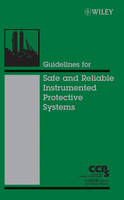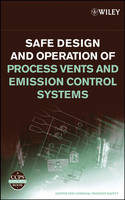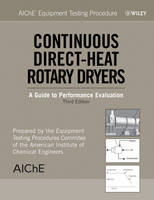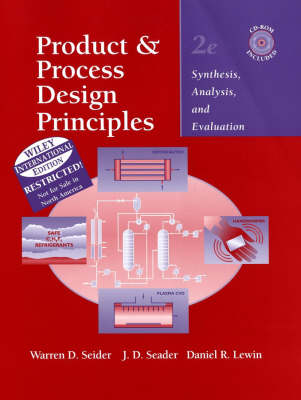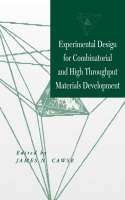Distillation Troubleshooting
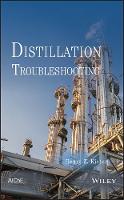 -15%
portes grátis
-15%
portes grátis
Distillation Troubleshooting
Kister, Henry Z.
John Wiley & Sons Inc
05/2006
752
Dura
Inglês
9780471467441
15 a 20 dias
1142
1.1 VLE 398
1.2 Chemistry, Process Sequence 402
1.3 Does Your Distillation Simulation Reflect the Real World? 404
1.4 Graphical Techniques to Troubleshoot Simulations 407
1.5 How Good Is Your Efficiency Estimate? 407
1.6 Simulator Hydraulic Predictions: To Trust or Not to Trust 409
2. Where Fractionation Goes Wrong 410
2.1 Insufficient Reflux or Stages; Pinches 410
2.2 No Stripping in Stripper 412
2.3 Unique Features of Multicomponent Distillation 412
2.4 Accumulation and Hiccups 413
2.5 Two Liquid Phases 419
2.6 Azeotropic and Extractive Distillation 421
3. Energy Savings and Thermal Effects 424
3.1 Energy-Saving Designs and Operation 424
3.2 Subcooling: How It Impacts Towers 428
3.3 Superheat: How It Impacts Towers 430
4. Tower Sizing and Material Selection Affect Performance 431
4.1 Undersizing Trays and Downcomers 431
4.2 Oversizing Trays 431
4.3 Tray Details Can Bottleneck Towers 433
4.4 Low Liquid Loads Can Be Troublesome 434
4.5 Special Bubble-Cap Tray Problems 436
4.6 Misting 437
4.7 Undersizing Packings 437
4.8 Systems Where Packings Perform Different from Expectations 437
4.9 Packed Bed Too Long 438
4.10 Packing Supports Can Bottleneck Towers 439
4.11 Packing Hold-downs Are Sometimes Troublesome 440
4.12 Internals Unique to Packed Towers 440
4.13 Empty (Spray) Sections 440
5. Feed Entry Pitfalls in Tray Towers 441
5.1 Does the Feed Enter the Correct Tray? 441
5.2 Feed Pipes Obstructing Downcomer Entrance 441
5.3 Feed Flash Can Choke Downcomers 441
5.4 Subcooled Feeds, Refluxes Are Not Always Trouble Free 442
5.5 Liquid and Unsuitable Distributors Do Not Work with Flashing Feeds 442
5.6 Flashing Feeds Require More Space 443
5.7 Uneven or Restrictive Liquid Split to Multipass Trays at Feeds and Pass Transitions 443
5.8 Oversized Feed Pipes 444
5.9 Plugged Distributor Holes 444
5.10 Low ?P Trays Require Decent Distribution 445
6. Packed-Tower Liquid Distributors: Number 6 on the Top 10 Malfunctions 446
6.1 Better Quality Distributors Improve Performance 446
6.2 Plugged Distributors Do Not Distribute Well 448
6.3 Overflow in Gravity Distributors: Death to Distribution 451
6.4 Feed Pipe Entry and Predistributor Problems 454
6.5 Poor Flashing Feed Entry Bottleneck Towers 455
6.6 Oversized Weep Holes Generate Undesirable Distribution 456
6.7 Damaged Distributors Do Not Distribute Well 457
6.8 Hole Pattern and Liquid Heads Determine Irrigation Quality 458
6.9 Gravity Distributors Are Meant to Be Level 459
6.10 Hold-Down Can Interfere with Distribution 460
6.11 Liquid Mixing Is Needed in Large-Diameter Distributors 460
6.12 Notched Distributors Have Unique Problems 461
6.13 Others 461
7. Vapor Maldistribution in Trays and Packings 462
7.1 Vapor Feed/Reboiler Return Maldistributes Vapor to Packing Above 462
7.2 Experiences with Vapor Inlet Distribution Baffles 465
7.3 Packing Vapor Maldistribution at Intermediate Feeds and Chimney Trays 465
7.4 Vapor Maldistribution Is Detrimental in Tray Towers 466
8. Tower Base Level and Reboiler Return: Number 2 on the Top 10 Malfunctions 468
8.1 Causes of High Base Level 468
8.2 High Base Level Causes Premature Tower Flood (No Tray/Packing Damage) 470
8.3 High Base Liquid Level Causes Tray/Packing Damage 471
8.4 Impingement by the Reboiler Return Inlet 472
8.5 Undersized Bottom Feed Line 475
8.6 Low Base Liquid Level 475
8.7 Issues with Tower Base Baffles 476
8.8 Vortexing 476
9. Chimney Tray Malfunctions: Part of Number 7 on the Top 10 Malfunctions 477
9.1 Leakage 477
9.2 Problem with Liquid Removal, Downcomers, or Overflows 478
9.3 Thermal Expansion Causing Warping, Out-of-Levelness 479
9.4 Chimneys Impeding Liquid Flow to Outlet 480
9.5 Vapor from Chimneys Interfering with Incoming Liquid 480
9.6 Level Measurement Problems 481
9.7 Coking, Fouling, Freezing 482
9.8 Other Chimney Tray Issues 482
10. Drawoff Malfunctions (Non-Chimney Tray): Part of Number 7 on the Top 10 Malfunctions 484
10.1 Vapor Chokes Liquid Draw Lines 484
10.2 Leak at Draw Tray Starves Draw 486
10.3 Draw Pans and Draw Lines Plug Up 488
10.4 Draw Tray Damage Affects Draw Rates 488
10.5 Undersized Side-Stripper Overhead Lines Restrict Draw Rates 488
10.6 Degassed Draw Pan Liquid Initiates Downcomer Backup Flood 489
10.7 Other Problems with Tower Liquid Draws 489
10.8 Liquid Entrainment in Vapor Side Draws 490
10.9 Reflux Drum Malfunctions 490
11. Tower Assembly Mishaps: Number 5 on the Top 10 Malfunctions 491
11.1 Incorrect Tray Assembly 491
11.2 Downcomer Clearance and Inlet Weir Malinstallation 491
11.3 Flow Passage Obstruction and Internals Misorientation at Tray Tower Feeds and Draws 492
11.4 Leaking Trays and Accumulator Trays 493
11.5 Bolts, Nuts, Clamps 493
11.6 Manways/Hatchways Left Unbolted 493
11.7 Materials of Construction Inferior to Those Specified 494
11.8 Debris Left in Tower or Piping 494
11.9 Packing Assembly Mishaps 495
11.10 Fabrication and Installation Mishaps in Packing Distributors 496
11.11 Parts Not Fitting through Manholes 498
11.12 Auxiliary Heat Exchanger Fabrication and Assembly Mishaps 498
11.13 Auxiliary Piping Assembly Mishaps 498
12. Difficulties during Start-Up, Shutdown, Commissioning, and Abnormal Operation: Number 4 on the Top 10 Malfunctions 499
12.1 Blinding/Unblinding Lines 499
12.2 Backflow 500
12.3 Dead-Pocket Accumulation and Release of Trapped Materials 501
12.4 Purging 501
12.5 Pressuring and Depressuring 502
12.6 Washing 502
12.7 On-Line Washes 504
12.8 Steam and Water Operations 506
12.9 Overheating 506
12.10 Cooling 507
12.11 Overchilling 507
12.12 Water Removal 508
12.12.1 Draining at Low Points 508
12.12.2 Oil Circulation 508
12.12.3 Condensation of Steam Purges 508
12.12.4 Dehydration by Other Procedures 508
12.13 Start-Up and Initial Operation 509
12.13.1 Total-Reflux Operation 509
12.13.2 Adding Components That Smooth Start-Up 509
12.13.3 Siphoning 509
12.13.4 Pressure Control at Start-Up 510
12.14 Confined Space and Manhole Hazards 510
13. Water-Induced Pressure Surges: Part of Number 3 on the Top 10 Malfunctions 512
13.1 Water in Feed and Slop 512
13.2 Accumulated Water in Transfer Line to Tower and in Heater Passes 513
13.3 Water Accumulation in Dead Pockets 513
13.4 Water Pockets in Pump or Spare Pump Lines 514
13.5 Undrained Stripping Steam Lines 515
13.6 Condensed Steam or Refluxed Water Reaching Hot Section 516
13.7 Oil Entering Water-Filled Region 517
14. Explosions, Fires, and Chemical Releases: Number 10 on the Top 10 Malfunctions 518
14.1 Explosions Due to Decomposition Reactions 518
14.2 Explosions Due to Violent Reactions 523
14.3 Explosions and Fires Due to Line Fracture 524
14.4 Explosions Due to Trapped Hydrocarbon or Chemical Release 527
14.5 Explosions Induced by Commissioning Operations 528
14.6 Packing Fires 529
14.7 Fires Due to Opening Tower before Cooling or Combustible Removal 533
14.8 Fires Caused by Backflow 534
14.9 Fires by Other Causes 535
14.10 Chemical Releases by Backflow 536
14.11 Trapped Chemicals Released 536
14.12 Relief, Venting, Draining, Blowdown to Atmosphere 537
15. Undesired Reactions in Towers 539
15.1 Excessive Bottom Temperature/Pressure 539
15.2 Hot Spots 539
15.3 Concentration or Entry of Reactive Chemical 539
15.4 Chemicals from Commissioning 540
15.5 Catalyst Fines, Rust, Tower Materials Promote Reaction 540
15.6 Long Residence Times 541
15.7 Inhibitor Problems 541
15.8 Air Leaks Promote Tower Reactions 542
15.9 Impurity in Product Causes Reaction Downstream 542
16. Foaming 543
16.1 What Causes or Promotes Foaming? 543
16.2 What Are Foams Sensitive To? 546
16.3 Laboratory Tests 547
16.4 Antifoam Injection 548
16.5 System Cleanup Mitigates Foaming 551
16.6 Hardware Changes Can Debottleneck Foaming Towers 555
17. The Tower as a Filter: Part A. Causes of Plugging-Number 1 on the Top 10 Malfunctions 558
17.1 Piping Scale/Corrosion Products 558
17.2 Salting Out/Precipitation 559
17.3 Polymer/Reaction Products 560
17.4 Solids/Entrainment in the Feed 561
17.5 Oil Leak 561
17.6 Poor Shutdown Wash/Flush 562
17.7 Entrainment or Drying at Low Liquid Rates 562
17.8 Others 562
18. The Tower as a Filter: Part B. Locations of Plugging-Number 1 on the Top 10 Malfunctions 563
18.1 Trays 563
18.2 Downcomers 564
18.3 Packings 565
18.4 How Packings and Trays Compare on Plugging Resistance 565
18.5 Limited Zone Only 567
18.6 Draw, Exchanger, and Vent Lines 569
18.7 Feed and Inlet Lines 570
18.8 Instrument Lines 570
19. Coking: Part of Number 1 on Tower Top 10 Malfunctions 571
19.1 Insufficient Wash Flow Rate, Refinery Vacuum Towers 571
19.2 Other Causes, Refinery Vacuum Towers 572
19.3 Slurry Section, FCC Fractionators 573
19.4 Other Refinery Fractionators 574
19.5 Nonrefinery Fractionators 574
20. Leaks 575
20.1 Pump, Compressor 575
20.2 Heat Exchanger 575
20.3 Chemicals to/from Other Equipment 577
20.4 Atmospheric 578
21. Relief and Failure 580
21.1 Relief Requirements 580
21.2 Controls That Affect Relief Requirements and Frequency 580
21.3 Relief Causes Tower Damage, Shifts Deposits 581
21.4 Overpressure Due to Component Entry 581
21.5 Relief Protection Absent or Inadequate 582
21.6 Line Ruptures 583
21.7 All Indication Lost When Instrument Tap Plugged 584
21.8 Trips Not Activating or Incorrectly Set 584
21.9 Pump Failure 585
21.10 Loss of Vacuum 585
21.11 Power Loss 585
22. Tray, Packing, and Tower Damage: Part of Number 3 on the Top 10 Malfunctions 586
22.1 Vacuum 586
22.2 Insufficient Uplift Resistance 587
22.3 Uplift Due to Poor Tightening during Assembly 587
22.4 Uplift Due to Rapid Upward Gas Surge 589
22.5 Valves Popping Out 590
22.6 Downward Force on Trays 590
22.7 Trays below Feed Bent Up, above Bent Down and Vice Versa 591
22.8 Downcomers Compressed, Bowed, Fallen 592
22.9 Uplift of Cartridge Trays 593
22.10 Flow-Induced Vibrations 593
22.11 Compressor Surge 594
22.12 Packing Carryover 595
22.13 Melting, Breakage of Plastic Packing 595
22.14 Damage to Ceramic Packing 595
22.15 Damage to Other Packings 595
23. Reboilers That Did Not Work: Number 9 on the Top 10 Malfunctions 596
23.1 Circulating Thermosiphon Reboilers 596
23.2 Once-Through Thermosiphon Reboilers 597
23.3 Forced-Circulation Reboilers 599
23.4 Kettle Reboilers 599
23.5 Internal Reboilers 602
23.6 Kettle and Thermosiphon Reboilers in Series 603
23.7 Side Reboilers 603
23.8 All Reboilers, Boiling Side 604
23.9 All Reboilers, Condensing Side 605
24. Condensers That Did Not Work 607
24.1 Inerts Blanketing 607
24.2 Inadequate Condensate Removal 608
24.3 Unexpected Condensation Heat Curve 609
24.4 Problems with Condenser Hardware 610
24.5 Maldistribution between Parallel Condensers 611
24.6 Flooding/Entrainment in Partial Condensers 611
24.7 Interaction with Vacuum and Recompression Equipment 612
24.8 Others 612
25. Misleading Measurements: Number 8 on the Top 10 Malfunctions 613
25.1 Incorrect Readings 613
25.2 Meter or Taps Fouled or Plugged 614
25.3 Missing Meter 615
25.4 Incorrect Meter Location 615
25.5 Problems with Meter and Meter Tubing Installation 616
25.6 Incorrect Meter Calibration, Meter Factor 617
25.7 Level Instrument Fooled 617
25.8 Meter Readings Ignored 619
25.9 Electric Storm Causes Signal Failure 619
26. Control System Assembly Difficulties 620
26.1 No Material Balance Control 620
26.2 Controlling Two Temperatures/Compositions Simultaneously Produces Interaction 621
26.3 Problems with the Common Control Schemes, No Side Draws 622
26.4 Problems with Side-Draw Controls 626
27. Where Do Temperature and Composition Controls Go Wrong? 629
27.1 Temperature Control 629
27.2 Pressure-Compensated Temperature Controls 632
27.3 Analyzer Control 633
28. Misbehaved Pressure, Condenser, Reboiler, and Preheater Controls 636
28.1 Pressure Controls by Vapor Flow Variations 636
28.2 Flooded Condenser Pressure Controls 637
28.3 Coolant Throttling Pressure Controls 640
28.4 Pressure Control Signal 641
28.5 Throttling Steam/Vapor to Reboiler or Preheater 641
28.6 Throttling Condensate from Reboiler 642
28.7 Preheater Controls 643
29. Miscellaneous Control Problems 644
29.1 Interaction with the Process 644
29.2 ?P Control 644
29.3 Flood Controls and Indicators 644
29.4 Batch Distillation Control 645
29.5 Problems in the Control Engineer's Domain 645
29.6 Advanced Controls Problems 646
References 649
Index 669
About the Author 713
1.1 VLE 398
1.2 Chemistry, Process Sequence 402
1.3 Does Your Distillation Simulation Reflect the Real World? 404
1.4 Graphical Techniques to Troubleshoot Simulations 407
1.5 How Good Is Your Efficiency Estimate? 407
1.6 Simulator Hydraulic Predictions: To Trust or Not to Trust 409
2. Where Fractionation Goes Wrong 410
2.1 Insufficient Reflux or Stages; Pinches 410
2.2 No Stripping in Stripper 412
2.3 Unique Features of Multicomponent Distillation 412
2.4 Accumulation and Hiccups 413
2.5 Two Liquid Phases 419
2.6 Azeotropic and Extractive Distillation 421
3. Energy Savings and Thermal Effects 424
3.1 Energy-Saving Designs and Operation 424
3.2 Subcooling: How It Impacts Towers 428
3.3 Superheat: How It Impacts Towers 430
4. Tower Sizing and Material Selection Affect Performance 431
4.1 Undersizing Trays and Downcomers 431
4.2 Oversizing Trays 431
4.3 Tray Details Can Bottleneck Towers 433
4.4 Low Liquid Loads Can Be Troublesome 434
4.5 Special Bubble-Cap Tray Problems 436
4.6 Misting 437
4.7 Undersizing Packings 437
4.8 Systems Where Packings Perform Different from Expectations 437
4.9 Packed Bed Too Long 438
4.10 Packing Supports Can Bottleneck Towers 439
4.11 Packing Hold-downs Are Sometimes Troublesome 440
4.12 Internals Unique to Packed Towers 440
4.13 Empty (Spray) Sections 440
5. Feed Entry Pitfalls in Tray Towers 441
5.1 Does the Feed Enter the Correct Tray? 441
5.2 Feed Pipes Obstructing Downcomer Entrance 441
5.3 Feed Flash Can Choke Downcomers 441
5.4 Subcooled Feeds, Refluxes Are Not Always Trouble Free 442
5.5 Liquid and Unsuitable Distributors Do Not Work with Flashing Feeds 442
5.6 Flashing Feeds Require More Space 443
5.7 Uneven or Restrictive Liquid Split to Multipass Trays at Feeds and Pass Transitions 443
5.8 Oversized Feed Pipes 444
5.9 Plugged Distributor Holes 444
5.10 Low ?P Trays Require Decent Distribution 445
6. Packed-Tower Liquid Distributors: Number 6 on the Top 10 Malfunctions 446
6.1 Better Quality Distributors Improve Performance 446
6.2 Plugged Distributors Do Not Distribute Well 448
6.3 Overflow in Gravity Distributors: Death to Distribution 451
6.4 Feed Pipe Entry and Predistributor Problems 454
6.5 Poor Flashing Feed Entry Bottleneck Towers 455
6.6 Oversized Weep Holes Generate Undesirable Distribution 456
6.7 Damaged Distributors Do Not Distribute Well 457
6.8 Hole Pattern and Liquid Heads Determine Irrigation Quality 458
6.9 Gravity Distributors Are Meant to Be Level 459
6.10 Hold-Down Can Interfere with Distribution 460
6.11 Liquid Mixing Is Needed in Large-Diameter Distributors 460
6.12 Notched Distributors Have Unique Problems 461
6.13 Others 461
7. Vapor Maldistribution in Trays and Packings 462
7.1 Vapor Feed/Reboiler Return Maldistributes Vapor to Packing Above 462
7.2 Experiences with Vapor Inlet Distribution Baffles 465
7.3 Packing Vapor Maldistribution at Intermediate Feeds and Chimney Trays 465
7.4 Vapor Maldistribution Is Detrimental in Tray Towers 466
8. Tower Base Level and Reboiler Return: Number 2 on the Top 10 Malfunctions 468
8.1 Causes of High Base Level 468
8.2 High Base Level Causes Premature Tower Flood (No Tray/Packing Damage) 470
8.3 High Base Liquid Level Causes Tray/Packing Damage 471
8.4 Impingement by the Reboiler Return Inlet 472
8.5 Undersized Bottom Feed Line 475
8.6 Low Base Liquid Level 475
8.7 Issues with Tower Base Baffles 476
8.8 Vortexing 476
9. Chimney Tray Malfunctions: Part of Number 7 on the Top 10 Malfunctions 477
9.1 Leakage 477
9.2 Problem with Liquid Removal, Downcomers, or Overflows 478
9.3 Thermal Expansion Causing Warping, Out-of-Levelness 479
9.4 Chimneys Impeding Liquid Flow to Outlet 480
9.5 Vapor from Chimneys Interfering with Incoming Liquid 480
9.6 Level Measurement Problems 481
9.7 Coking, Fouling, Freezing 482
9.8 Other Chimney Tray Issues 482
10. Drawoff Malfunctions (Non-Chimney Tray): Part of Number 7 on the Top 10 Malfunctions 484
10.1 Vapor Chokes Liquid Draw Lines 484
10.2 Leak at Draw Tray Starves Draw 486
10.3 Draw Pans and Draw Lines Plug Up 488
10.4 Draw Tray Damage Affects Draw Rates 488
10.5 Undersized Side-Stripper Overhead Lines Restrict Draw Rates 488
10.6 Degassed Draw Pan Liquid Initiates Downcomer Backup Flood 489
10.7 Other Problems with Tower Liquid Draws 489
10.8 Liquid Entrainment in Vapor Side Draws 490
10.9 Reflux Drum Malfunctions 490
11. Tower Assembly Mishaps: Number 5 on the Top 10 Malfunctions 491
11.1 Incorrect Tray Assembly 491
11.2 Downcomer Clearance and Inlet Weir Malinstallation 491
11.3 Flow Passage Obstruction and Internals Misorientation at Tray Tower Feeds and Draws 492
11.4 Leaking Trays and Accumulator Trays 493
11.5 Bolts, Nuts, Clamps 493
11.6 Manways/Hatchways Left Unbolted 493
11.7 Materials of Construction Inferior to Those Specified 494
11.8 Debris Left in Tower or Piping 494
11.9 Packing Assembly Mishaps 495
11.10 Fabrication and Installation Mishaps in Packing Distributors 496
11.11 Parts Not Fitting through Manholes 498
11.12 Auxiliary Heat Exchanger Fabrication and Assembly Mishaps 498
11.13 Auxiliary Piping Assembly Mishaps 498
12. Difficulties during Start-Up, Shutdown, Commissioning, and Abnormal Operation: Number 4 on the Top 10 Malfunctions 499
12.1 Blinding/Unblinding Lines 499
12.2 Backflow 500
12.3 Dead-Pocket Accumulation and Release of Trapped Materials 501
12.4 Purging 501
12.5 Pressuring and Depressuring 502
12.6 Washing 502
12.7 On-Line Washes 504
12.8 Steam and Water Operations 506
12.9 Overheating 506
12.10 Cooling 507
12.11 Overchilling 507
12.12 Water Removal 508
12.12.1 Draining at Low Points 508
12.12.2 Oil Circulation 508
12.12.3 Condensation of Steam Purges 508
12.12.4 Dehydration by Other Procedures 508
12.13 Start-Up and Initial Operation 509
12.13.1 Total-Reflux Operation 509
12.13.2 Adding Components That Smooth Start-Up 509
12.13.3 Siphoning 509
12.13.4 Pressure Control at Start-Up 510
12.14 Confined Space and Manhole Hazards 510
13. Water-Induced Pressure Surges: Part of Number 3 on the Top 10 Malfunctions 512
13.1 Water in Feed and Slop 512
13.2 Accumulated Water in Transfer Line to Tower and in Heater Passes 513
13.3 Water Accumulation in Dead Pockets 513
13.4 Water Pockets in Pump or Spare Pump Lines 514
13.5 Undrained Stripping Steam Lines 515
13.6 Condensed Steam or Refluxed Water Reaching Hot Section 516
13.7 Oil Entering Water-Filled Region 517
14. Explosions, Fires, and Chemical Releases: Number 10 on the Top 10 Malfunctions 518
14.1 Explosions Due to Decomposition Reactions 518
14.2 Explosions Due to Violent Reactions 523
14.3 Explosions and Fires Due to Line Fracture 524
14.4 Explosions Due to Trapped Hydrocarbon or Chemical Release 527
14.5 Explosions Induced by Commissioning Operations 528
14.6 Packing Fires 529
14.7 Fires Due to Opening Tower before Cooling or Combustible Removal 533
14.8 Fires Caused by Backflow 534
14.9 Fires by Other Causes 535
14.10 Chemical Releases by Backflow 536
14.11 Trapped Chemicals Released 536
14.12 Relief, Venting, Draining, Blowdown to Atmosphere 537
15. Undesired Reactions in Towers 539
15.1 Excessive Bottom Temperature/Pressure 539
15.2 Hot Spots 539
15.3 Concentration or Entry of Reactive Chemical 539
15.4 Chemicals from Commissioning 540
15.5 Catalyst Fines, Rust, Tower Materials Promote Reaction 540
15.6 Long Residence Times 541
15.7 Inhibitor Problems 541
15.8 Air Leaks Promote Tower Reactions 542
15.9 Impurity in Product Causes Reaction Downstream 542
16. Foaming 543
16.1 What Causes or Promotes Foaming? 543
16.2 What Are Foams Sensitive To? 546
16.3 Laboratory Tests 547
16.4 Antifoam Injection 548
16.5 System Cleanup Mitigates Foaming 551
16.6 Hardware Changes Can Debottleneck Foaming Towers 555
17. The Tower as a Filter: Part A. Causes of Plugging-Number 1 on the Top 10 Malfunctions 558
17.1 Piping Scale/Corrosion Products 558
17.2 Salting Out/Precipitation 559
17.3 Polymer/Reaction Products 560
17.4 Solids/Entrainment in the Feed 561
17.5 Oil Leak 561
17.6 Poor Shutdown Wash/Flush 562
17.7 Entrainment or Drying at Low Liquid Rates 562
17.8 Others 562
18. The Tower as a Filter: Part B. Locations of Plugging-Number 1 on the Top 10 Malfunctions 563
18.1 Trays 563
18.2 Downcomers 564
18.3 Packings 565
18.4 How Packings and Trays Compare on Plugging Resistance 565
18.5 Limited Zone Only 567
18.6 Draw, Exchanger, and Vent Lines 569
18.7 Feed and Inlet Lines 570
18.8 Instrument Lines 570
19. Coking: Part of Number 1 on Tower Top 10 Malfunctions 571
19.1 Insufficient Wash Flow Rate, Refinery Vacuum Towers 571
19.2 Other Causes, Refinery Vacuum Towers 572
19.3 Slurry Section, FCC Fractionators 573
19.4 Other Refinery Fractionators 574
19.5 Nonrefinery Fractionators 574
20. Leaks 575
20.1 Pump, Compressor 575
20.2 Heat Exchanger 575
20.3 Chemicals to/from Other Equipment 577
20.4 Atmospheric 578
21. Relief and Failure 580
21.1 Relief Requirements 580
21.2 Controls That Affect Relief Requirements and Frequency 580
21.3 Relief Causes Tower Damage, Shifts Deposits 581
21.4 Overpressure Due to Component Entry 581
21.5 Relief Protection Absent or Inadequate 582
21.6 Line Ruptures 583
21.7 All Indication Lost When Instrument Tap Plugged 584
21.8 Trips Not Activating or Incorrectly Set 584
21.9 Pump Failure 585
21.10 Loss of Vacuum 585
21.11 Power Loss 585
22. Tray, Packing, and Tower Damage: Part of Number 3 on the Top 10 Malfunctions 586
22.1 Vacuum 586
22.2 Insufficient Uplift Resistance 587
22.3 Uplift Due to Poor Tightening during Assembly 587
22.4 Uplift Due to Rapid Upward Gas Surge 589
22.5 Valves Popping Out 590
22.6 Downward Force on Trays 590
22.7 Trays below Feed Bent Up, above Bent Down and Vice Versa 591
22.8 Downcomers Compressed, Bowed, Fallen 592
22.9 Uplift of Cartridge Trays 593
22.10 Flow-Induced Vibrations 593
22.11 Compressor Surge 594
22.12 Packing Carryover 595
22.13 Melting, Breakage of Plastic Packing 595
22.14 Damage to Ceramic Packing 595
22.15 Damage to Other Packings 595
23. Reboilers That Did Not Work: Number 9 on the Top 10 Malfunctions 596
23.1 Circulating Thermosiphon Reboilers 596
23.2 Once-Through Thermosiphon Reboilers 597
23.3 Forced-Circulation Reboilers 599
23.4 Kettle Reboilers 599
23.5 Internal Reboilers 602
23.6 Kettle and Thermosiphon Reboilers in Series 603
23.7 Side Reboilers 603
23.8 All Reboilers, Boiling Side 604
23.9 All Reboilers, Condensing Side 605
24. Condensers That Did Not Work 607
24.1 Inerts Blanketing 607
24.2 Inadequate Condensate Removal 608
24.3 Unexpected Condensation Heat Curve 609
24.4 Problems with Condenser Hardware 610
24.5 Maldistribution between Parallel Condensers 611
24.6 Flooding/Entrainment in Partial Condensers 611
24.7 Interaction with Vacuum and Recompression Equipment 612
24.8 Others 612
25. Misleading Measurements: Number 8 on the Top 10 Malfunctions 613
25.1 Incorrect Readings 613
25.2 Meter or Taps Fouled or Plugged 614
25.3 Missing Meter 615
25.4 Incorrect Meter Location 615
25.5 Problems with Meter and Meter Tubing Installation 616
25.6 Incorrect Meter Calibration, Meter Factor 617
25.7 Level Instrument Fooled 617
25.8 Meter Readings Ignored 619
25.9 Electric Storm Causes Signal Failure 619
26. Control System Assembly Difficulties 620
26.1 No Material Balance Control 620
26.2 Controlling Two Temperatures/Compositions Simultaneously Produces Interaction 621
26.3 Problems with the Common Control Schemes, No Side Draws 622
26.4 Problems with Side-Draw Controls 626
27. Where Do Temperature and Composition Controls Go Wrong? 629
27.1 Temperature Control 629
27.2 Pressure-Compensated Temperature Controls 632
27.3 Analyzer Control 633
28. Misbehaved Pressure, Condenser, Reboiler, and Preheater Controls 636
28.1 Pressure Controls by Vapor Flow Variations 636
28.2 Flooded Condenser Pressure Controls 637
28.3 Coolant Throttling Pressure Controls 640
28.4 Pressure Control Signal 641
28.5 Throttling Steam/Vapor to Reboiler or Preheater 641
28.6 Throttling Condensate from Reboiler 642
28.7 Preheater Controls 643
29. Miscellaneous Control Problems 644
29.1 Interaction with the Process 644
29.2 ?P Control 644
29.3 Flood Controls and Indicators 644
29.4 Batch Distillation Control 645
29.5 Problems in the Control Engineer's Domain 645
29.6 Advanced Controls Problems 646
References 649
Index 669
About the Author 713



